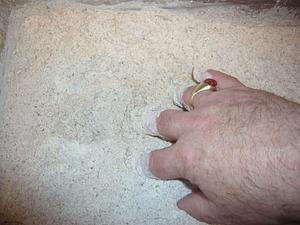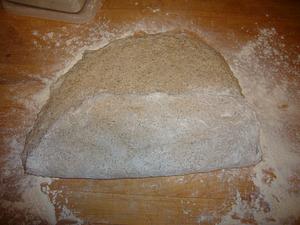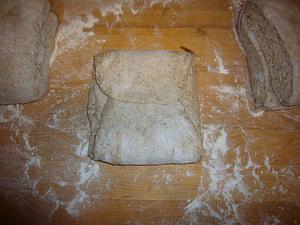No-Knead Jewish Rye
Ingredients
| 908 | grams | Starter | 50/50 |
| 500 | grams | Water | |
| 400 | grams | Flour, High Gluten | |
| 500 | grams | Flour, Rye | |
| 28 | gram | Salt, Flour | |
| 28 | gram | Caraway Seeds |
Instructions
Best way to go is to make the starter and adjust the ingredients by percentage of the starter. Assuming it's a white flour starter, and you're using the hobart, add:
55% of the starter weight in water
30% of the starter weight more in white flour
100% of the starter weight rye flour
3.25% of the starter weight in caraway seeds
3.25% of the starter weight in salt (after autolyse)

The starter is a 50/50 mix (1/2 flour and 1/2 water). Thin the starter with the water and mix in the salt and the caraway seeds. I use flour salt so it's easier to dissolve. Add the rye and AP flours. NOTE: You can mix the rye with 50% pumpernickel if you want, but I don't like all pump... Some of the pictures are with pump included. The process is the same.

Mix the ingredients with your hand. Use only one, keeping the other clean. Note, most of my no knead breads are 80% hydration, this one is 70%. The rye flour doesn't develop sufficient gluten to maintain a good shape when hydrated to 80%.

Mix until the flour is all moistened and the dough comes together. It may be rough, especially if you added pump.

Follow the instructions for the no knead baguettes for stretching the dough every 20 minutes for an hour. This dough will NOT be near as elastic as the baguette dough, and it will tend to break when you try to stretch it. Just slap it back together and continue to stretch. After the last stretch, let it rest 20 minutes, and turn it out onto a floured work surface and pat it out.

Fold the bottom third up onto the middle third

Sorry, I forgot to take pictures, but after the 20 minutes you want to shape each loaf into the desired shape. Place on a floured canvas and allow to proof. This period should be at least 2.5 hours and depending on the temperature of the room as much as 8. During this time, the bacteria does its work, and the longer you can wait, the more sour the bread will be. Watch your dough. You want it to rise, but not overly so. The picture here shows properly raised dough.

Fold the top third down onto the other 2 thirds.

Rotate the dough 90 degrees and pat out. Fold the top quarter over onto the 2nd quarter, and the bottom quarter over onto the 3rd quarter.

Fold the bottom two quarters over onto the top two quarters, and rotate the dough 90 degrees.

Divide the dough into 3 equal portions.

Pat a portion out.

Fold the top quarter over onto the 2nd quarter, and the bottom quarter over onto the 3rd quarter.

Fold the bottom 2 quarters over onto the top 2 quarters. Set the dough on a board and allow to rest for 20 minutes.

Place the loaves on a peel sprinkled with coarse corn meal. Score the loaves (I use 7 perpendicular slashes on ryes). Wash with a cooked water and corn starch solution (this should be thickened, but not jello like), and then sprinkle with additional caraway seeds. Bake at 425F for convection with steam. 475 without convection. Try to add steam in either configuration. I bake for 5 minutes with steam, and 20 more minutes without.

Remove from oven, and immediately apply a 2nd coat of the corn starch solution. This 2nd coat will make the loaves shinny. Allow to cool, and enjoy. NOTE: Picture is of loaf with 80% hydration. Notice how it spread out instead of a proper shape?

Another picture showing the shine from the 2nd coat of corn starch.
Warren said, about 6 years ago |

Adjusted the ingredients today, substituting more white flour for rye and switching to high gluten flour, hoping to stop loaves from breaking while rising. I think the starter should be made with high gluten as well.